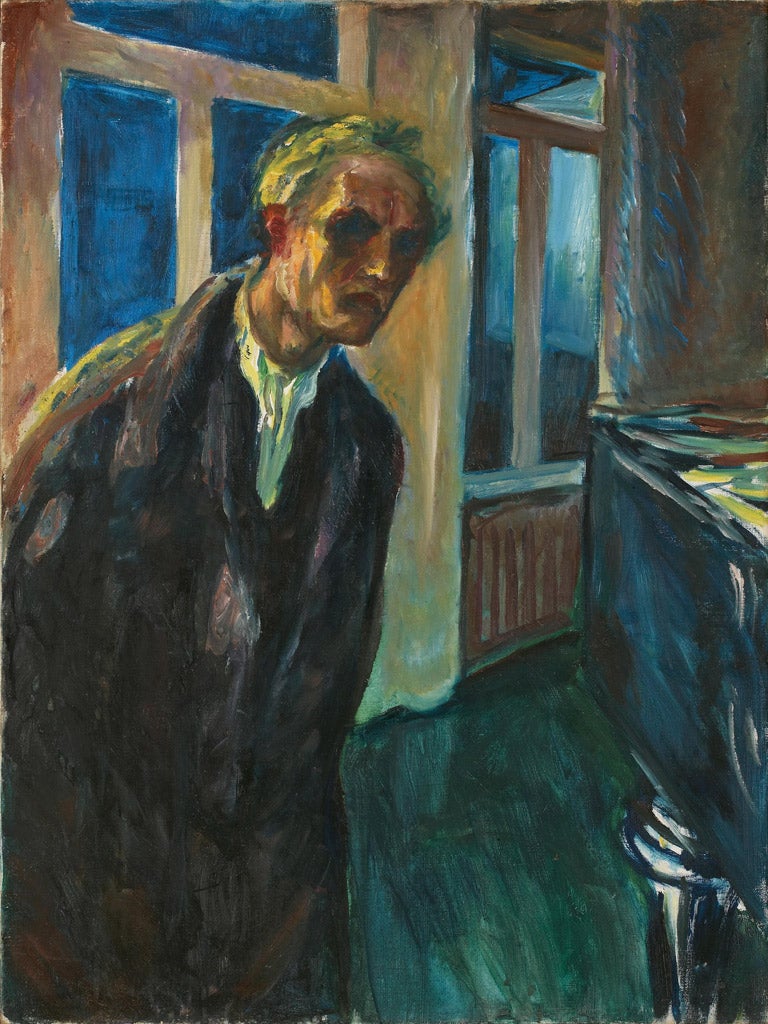Edvard Munch: The Modern Eye, Tate Modern, London
Few artists are so defined by a single image, but with no Scream pictures to steal the show, the Norwegian hypochondriac is seen in a new light

In the spring of 1930, Edvard Munch suffered a haemorrhage in his right eye. Munch's left eye had always been weak: the right was his strong eye, his painting eye. Now, there was a blind spot in the middle of its field of vision, ringed with a penumbra of concentric colours.
For any other artist, this might have been a catastrophe. Munch, inset below, was delighted. The bleed in his eye united his twin obsessions, with the subjectivity of seeing and his own ill health.
The images he made in the months it took the haemorrhage to clear are among the most arresting in Tate Modern's new show, Edvard Munch: The Modern Eye. In Self-Portrait with Wounded Eye, the damaged organ is shown as an abstract circle or blur, the thing that sees and the thing seen becoming confused with each other. The subject of Disturbed Vision is the eye's blind spot, an ominous blob that pushes the incidental scene of a bedroom and an apparently naked woman out to the edge of the composition. The picture raises a question. Just as sculpture is made up of solids and voids, so painting consists of things visible and invisible. Which, Munch's half-blind image asks, are the more real?
As the show's title suggests, the aim is to fast forward our idea of Munch's place in art history from a late follower of Symbolism to an outrider of Modernism. Wall texts point out that most of his life – certainly most of his career – was spent in the 20th century. (Munch was born in 1863 and died in 1944.) This is, of course, no guarantee of Modernity, or even of being modern: the same thing might be said of Stanley Spencer. Compare The Artist's Injured Eye: Three Optical Illusions with the colour circles of Kandinsky, painted nearly 20 years before, and the idea of Munch the Modernist becomes a shade far-fetched.
This is not to say that he is not an interesting painter, nor that this is not a useful show. We don't often get to see Munch works en masse in Britain: the Tate owns just one, The Sick Child (1907). Additionally, the Norwegian suffers more than any other artist I can think of from one-work syndrome, the one picture we all think we can name being The Scream. (Actually, one of four variants of an image properly called The Scream of Nature). So, if not a Modernist, what is the Munch that emerges from Tate's oversized exhibition?
To tell you the truth, I'm not sure of the word for it. There is a strain of morbidity in European art that starts with Baudelaire and runs, via Art Nouveau, to Thomas Mann. Mann began Magic Mountain in the year that Munch made the last of his Screams. The Norwegian, with his alcoholism and endless maladies, could have been a patient in Mann's Swiss sanatorium. Munch's fascination is not only with bodily illness but with psychic ones. Alongside images of operating tables and deathbed scenes – his sister's, his best friend's – are others of pathological mental states: murderers, depressives, the biographically true picture of the artist himself pointing a rifle at friends who had annoyed him.
All of this Munch rendered in paint which itself spoke of fragility, thin-washed, jagged, translucent, neurotically coloured, with steep recessions that bring on a kind of vertigo of the soul. The Tate may be right that these things were influenced by the Norwegian's interest in photography, still and moving – canvases in the show are interspersed with Munch's photographs and oddly violent short films. But cropping and cutting do not seem central to his work in the way that they were to, say, Degas'. They do not make Munch a Modernist.
If your only tool is a hammer, every problem looks like a nail. If you're a curator at a gallery called Tate Modern, then what you see is Modernism. For what it's worth, I think this show is misnamed: "The Wounded Eye" would be a more accurate subtitle than The Modern Eye. In its last room is a series of self-portraits painted between 1905 and 1943. They chart, with horrifying off-handedness, the course of Munch's own self-destruction. As they progress (or regress), the portraits' eyes disappear: in The Night Wanderer of 1923-24, they seem to have been gouged out. It is as if Munch wants to blind himself, as though he cannot bear to see the thing in the mirror in front of him. It is a terrifying image, modern or not. See it if you can.
To 14 Oct (020-7887 8888)
Critic's Choice
Tune in to the shared resonances of Turner, Monet, Twombly: Later Paintings as their work is hung side by side in this big summer show at Tate Liverpool (till 28 Oct). Or, for a very different compare-and-contrast, head to London’s Tate Britain to catch the last days of Picasso & Modern British Art – it closes on 15 July.
Join our commenting forum
Join thought-provoking conversations, follow other Independent readers and see their replies
Comments
Bookmark popover
Removed from bookmarks